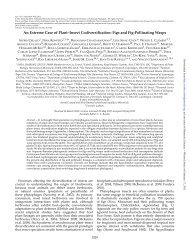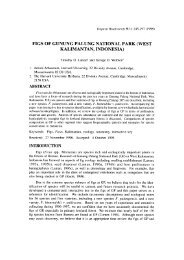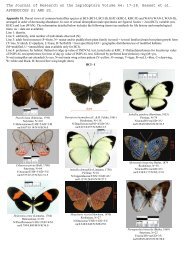Supporting Information
Supporting Information
Supporting Information
Create successful ePaper yourself
Turn your PDF publications into a flip-book with our unique Google optimized e-Paper software.
Fig. S1. Phylogenetic relationships among the studied plant species.<br />
Branch lengths are proportional to the number of nucleotide substitutions in rbcL sequences. Branch<br />
lengths for most clades were approximated using 1,285 base pairs of aligned chloroplast DNA<br />
encoding ribulose-1,5-bisphosphate carboxylase (rbcL) in 92 host plant species (Table S2,<br />
Appendix S1). Congeneric rbcL sequences from Genbank were substituted in 12 cases where DNA<br />
sequences could not be obtained from local host species. These included Aceratium oppositifolum<br />
for Aceratium ledermannii, Amaracarpus sp. for Amaracarpus calcicola, Barringtonia apiculata<br />
for B. calyptrocalyx, Casearia sylvestris for C. erythrocarpa, Eupomatia bennettii for E. laurina,<br />
Garcinia latissima for G. cf. hollungii, Horsfeldia basifissa for H. spicata, Litsea collina for Litsea<br />
sp., Microcos argentata for Microcos sp., Phaleria sp. for P. macrocarpa, Terminalia complanata<br />
for Terminalia sp., and Uvaria rosenbergiana for Uvaria sp. A general time-reversible model of<br />
molecular evolution with parameters for invariant sites and rate heterogeneity among sites<br />
(GTR+I+G) was selected according to the Aikake <strong>Information</strong> Criterion (Posada & Buckley 2004).<br />
Maximum likelihood (ML) heuristic searches were conducted with topological constraints enforced<br />
according to relationships among angiosperm clades supported by >90% bootstrap values in<br />
previous three-gene analyses (Soltis et al. 1998). This approach assumed the monophyly of families<br />
and orders classified according to angiosperm phylogeny (APG II 2003) with the advantage of<br />
avoiding spurious topology based on a limited community sample while resolving relationships<br />
among taxa not included in previous molecular systematic studies. Branch lengths were optimized<br />
with PAUP* (Swofford 1998) and GTR+I+G model parameters estimated from rbcL sequences on<br />
the ML tree. Phylogeny estimates for three locally diverse host plant clades were obtained by<br />
independent analyses of a gene encoding a subunit of NADH-plastoquinone oxidoreductase (ndhF)<br />
for Euphorbiaceae and the internal transcribed spacer region of nuclear ribosomal DNA (ITS) for<br />
Ficus (Moraceae) and Syzygium (Myrtaceae). Topologies and branch lengths were estimated for<br />
each clade separately according to the procedure outlined for rbcL except that topological<br />
constraints were not enforced. These independent phylogeny estimates were grafted to the rbcL<br />
phylogeny. Branch lengths estimated from ndhF and ITS were rescaled relative to rbcL using<br />
genetic distances between pairs of taxa in each of the three clades. The rate of ITS relative to rbcL<br />
molecular evolution in Ficus, for example, was calculated by dividing the number of rbcL<br />
substitutions per site under ML separating F. microcarpa from F. variegata by the number of ITS<br />
substitutions per site. In particular, rbcL sequences from F. microcarpa and F. variegata differed by<br />
0.0039 substitutions per site compared to 0.0960 for ITS, yielding a rate of 0.041, by which ITS<br />
branch lengths were multiplied to express them in rbcL units on the community phylogeny. The rate<br />
for Syzygium, based on comparison of S. longipes and Syzygium sp. 1, was 0.289. The rate for ndhF<br />
relative to rbcL was 0.393 ± 0.0148 based on comparisons of substitutions per site among<br />
Macaranga aleuritoides, Mallotus peltatus, and Melanolepis multiglandulosa. We rescaled the<br />
branch lengths by these rates to approximate the phylogenetic distance between taxa sampled for<br />
genes with different rates of molecular divergence. The assumption of this method is that rates of<br />
divergence for each gene are homogeneous among community members.<br />
4






